In Search of The Lamb
Researches & Conclusions of
Brigadier Allen P Block CB CBE DSO
General Background
Over the years various investigations about the Lamb to explain where and when it was adapted as the badge of the Regiment have taken place. One of the most comprehensive of these was by Brigadier Allen Black in 1965/1966.
The results of his investigations were published in three articles in the Queen's Royal Surrey Regimental Journals. The results of the first of these is summarized below:
In March 1965 Brigadier Block went to Portugal and visited first:
The Lisbon Military Museum where it was confirmed that the Coat of Arms of the Royal House of Portugal did not, and never included a Lamb in any form or shape.
then;
The Braganza Museum at the seat of the Duke of Braganza. The family became Royal when in 1640 John, Duke of Braganza who was the father of Catherine, became King John IVth. The Braganzas though do not include a Lamb in any form in their Coat of Arms. However, in the Chapel located within the Castle and the Palace at the site there is a statue of St John the Baptist with a lamb at his feet, indicating a connection to the family.
Later at Oporto Brigadier Block met the Chamberlain to the present Duke, who remained Pretender to the Throne of Portugal. He stated that St John the Baptist was indeed the patron saint of King John IVth.
Brigadier Block concluded that it would seem possible therefore that Queen Catherine might have taken the Lamb or Paschal lamb as her personal crest to continue her family connection.
The Brigadier finally concluded with a note on St John the Baptist:-
A Note on St John The Baptist
| "In my extensive research into the emblematic use of the 'Paschal Lamb' world wide, I have found that wherever an institution has at its patron saint St John The Baptist there is to be found the 'Paschal Lamb' in various heraldic attitudes, either as a badge or within a coat of arms. As examples:- Towns: Ayr, Perth, Preston, Halifax, Penzance, Yeovil, Hendon, Axbridge, Lubeck (Germany), Gotland (Sweden) and probably Velsen (Holland), Orleans (France) and others in Europe. Institutions:- Knights Templar, Middle Temple, Venerable Order of St John, St John's College Oxford, Merchant Taylors Company, Merchant Taylors School, Halifax Building Society, General Accident Assurance Company and doubtless many more." |
It is unlikely that Catherine had St John The Baptist as her patron saint because female Roman Catholics have female patron saints. However, she could have had a devotion to him, and therefore taken the 'Lamb' or the 'Paschal Lamb' as her personal crest.
The Braganza Connection:
His second article left this research with good evidence that Queen Catherine had a devotion for St. John the Baptist, and, therefore, that it was likely that the, Paschal Lamb was her crest or symhol. "Behold the Lamb of God" - St. John ch. 1, v. 29.
He had received a letter from the Curator of the Braganza Museum in Vila Vicosa in Portugal. In it he refers to a chasuble which is a sleeveless vestment of the celebrant at Mass, and is the property of the Braganza family. It has lately been returned to the Museum from Lisbon. It "could belong to the 16th Century or, at the latest, the 17th, and forms part of a set of twelve articles all in red velvet with gold thread ornamentation - They all show a Lamb, with an unfurled banner...."
The curator gives it as his opinion that they belonged to Queen Catherine.
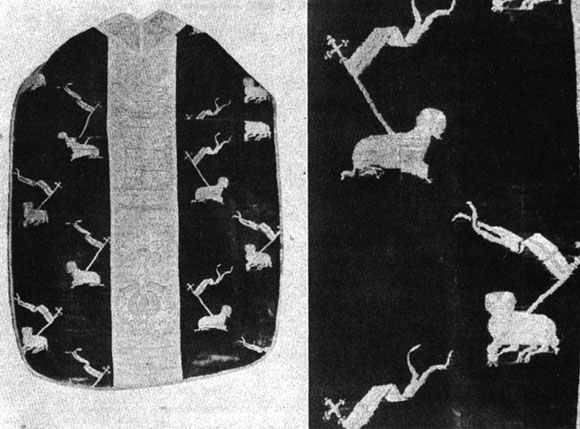 |
| Chasuble of The Braganza Family (left, and detail (right). |
(Two photographs of this chasuble are reproduced with this article, one showing the whole, the other a detail.)
This further circumstantial evidence was unexpected and a lucky break in research. In my opinion it confirms that it was through Queen Catherine's influence that The Queen's Regiment had as their crest, the Paschal Lamb.
Finally Brigadier Block summed up all his researches by concluding that the accumulation of circumstantial evidence establishes that it was through the connection with and influence from Queen Catherine that the Queen's Regiment received the badge of the Paschal Lamb, but that just when and how cannot be known.
The Rowe Connection
The Brigadier had been in communication with two Rowe families, one of whom changed its name to FisherRowe at the end of the nineteenth century. (The two armorial bearing are reproduced in this article). It will be seen that there are plenty of Paschal Lambs here which could have been taken as our Badge.
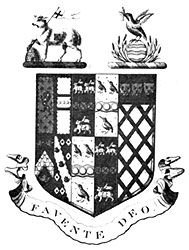 |
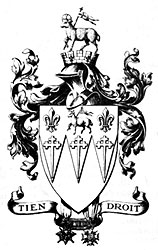 |
|
| The Armorial Bearings of the Fisher Rowe Family | The Armorial Bearings of the Rowe Family |
The Rowe family cannot trace their line back beyond 1713 which is only a generation away from our Henry Rowe. The Fisher-Rowe's family tree goes back to 1540. Brigadier Blockexamined this. Unfortunately there is no Henry in this tree until 1758, nor any Army connection at the end of the seventeenth century. So this line of research, though most interesting, has led to no defmite conclusion.
Both families come from the West Country. The Rowes are mentioned in Parish Registers in the area of Probus in Cornwall, and Lamerton in Devon. The FisherRowes moved from Shobrooke, near Crediton in Devon to Thorncombe, near Guildford in Surrey about the middle of the eighteenth century.
The Rowe Connection:
I have had an even luckier break in this research. Quite unexpectedly I heard from a .Mr. J. Y. Rowe, from Ottawa, Canada. He had heard from a member of the Rowe family in England to whom I had written, that I was undertaking research into the family of Colonel Henry Rowe, who commanded the Queen's in 1689 as a Lieutenant Colonel.
Mr. J. Y. Rowe made reference to "Calendar of State Papers Domestic" and to "The History and Antiquities of Hackney, vol. 2, page 10," where it is established that there is a Rowe chapel in the Church of St. Augustine. This Rowe family came from Kent. and there is no Paschal Lamb in their armorial bearings. So that research has come to a conclusion.
What happened to Colonel Henry Rowe after leaving the Queen's is interesting.
State Papers
1692. 1st February, page 120.
"Commission to Colonel Henry Rowe to be Colonel of the Regiment of Foot lately commanded by Lieutenant-General Douglass. and likewise to be Captain of a Company in the same Regiment."
1695. 12th March. page 316.
"On Saturday last Colonel Rowe was tried by a Court. Martial upon some complaints made against him by his officers and was suspended."
1695. 13th March, page 402.
"Commission for Thomas Bindenell to be Colonel of Colonel Henry Rowe's late Regiment."
The History and Antiquities of Hackney
From the family tree it will be seen that Colonel Henry Rowe had some distinguished ancestors.
Sir Thomas Rowe |
- |
Mary, daughter of Sir John Gresham, Mayor of London |
l |
|
|
Sir Henry Howe |
- |
Susan, daughter of Thomas Kightley |
l |
|
|
Sir Henry Rowe |
- |
Anne, daughter of Anthony Langton |
|
|
|
Henry Rowe Lieutenant-Colonel of The Queen's, 1689 |
||
Conclusion
Brigadier Block wrote "It is unlikely that I shall get any further direct evidence in my Braganza research. Personally, I am satisfied with the accumulation of circumstantial evidence. Just when and how the Queen's Regiment received their crest. of the Paschal Lamb may never he known.
Let us hope that, whatever reorganisation takes place In the future, one of the oldest crests in the Army will be maintained In some form."
Following on Brigadier Block reported on his further researches in two directions in his second article in the Regimental Journal in December 1966. These researches covered:
- The Braganza Connection to establish that the 'Lamb' or 'Paschal Lamb' was the Crest of Queen Catherine or the Badge of the House of Braganza.
- The Rowe Connection to investigate the connection of Lieutenant Colonel Henry Rowe, who commanded the Regiment in 1689, with a Rowe Family who had the Paschal Lamb as their crest. In the early days most Regiments were referred to by the name of their commander and did not take their badges from the armorial bearings of their then Colonel.
The results of these researches were:-
The Braganza Connection
In reply to much correspondence he reported that he had the following authoritative and significant replies.
- From the Royal Academy Exhibition of the King's Pictures 1946/47, extract from description in the catalogue of Jacob Huysman's Portrait of Queen Catherine: 'The Paschal Lamb was the Queen's emblem and is still worn by the (Queen's) Regiment.'
- From the Public Record Office dated 4th August 1965 'The Paschal Lamb was certainly the badge of the House of Braganza.'
- From the ex-President of St John's College, Oxford, 23rd November 1964, 'I believe that Catherine of Braganza was also a devotee of St John The Baptist and that is, I think, why the Queen's Regiment has the same badge as ourselves.'
- From the Catholic Truth Society, dated 5th January 1965 'I have made enquiries (from the College of Arms) and find that the emblem of the Lamb was the House Badge of the House of Braganza.'
- From Symbols and Signs by Arnold Whittick, published 1960 page 32 'For example, the 'Paschal Lamb' of the Queen's West Surrey Regiment was the Crest of Catherine of Braganza, wife of Charles 11, after whom the Regiment was named at its foundation in 1661'. Page 203 'It (the Paschal Lamb) was well known as the Badge of the rd Queen's Surrey Regiment .'
- From Walton's History of the British Standing Army 1660-1700, published 1894, page 12, 'It is now the Second or Queen's Regiment of Foot and it still retains the Crest of the Paschal Lamb. This Crest was a national emblem of Portugal and appears to have been selected as a compliment of the Queen's nationality, and as a suitable insignia for the Regiment bearing her name.'
- From The Encylopaedia Britannica (Eleventh Edition) under Kirke, Percy: 'On the evacuation of Tangier, Kirke's Lambs (so called from their badge) returned to England.'
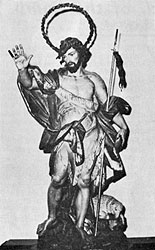 |
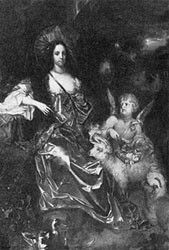 |
| Reproduced by gracious permission of Her Majesty The Queen. |
But he also discovered three pieces of circumstantial evidence which are important.
- There is a portrait already referred to, in Windsor Castle of Queen Catherine by Jacob Huysman with four lambs, two in the foreground two in the background. (This is reproduced in this article). Apparently Catherine set the fashion for Ladies of the Court to be painted with lambs within their portraits.
- I have discovered without reasonable doubt that St John The Baptist was the patron saint of King John IV of Portugal, the first of the Royal Braganza line, and father of Queen Catherine. He was the fourth John of Braganza in the direct line of descent. Wherever St John The Baptist is the patron saint there is to be found, as a crest or symbol, the Lamb. (A photograph of the statue of St John The Baptist extant in the Chapel of the Braganza Foundation at Vila Vicosa in Portugal, is reproduced in this article).
- In July 1966, Lieutenant Colonel Desmond Lang, Royal Artillery, British Military Attache in Portugal, visited the Palace of Guimaraes, fifty kilometers north-east of Oporto. This was the property of the Braganza family. Therein he found a Pastrana Tapestry symbolising the capture of Tangier by troops under the command of Don Joao de Braganza in 1471. The mounted troops were carrying lances the pennants of which were the Cross of St George, similar to that carried by the Regimental Paschal Lamb. In another room was a portrait of Catherine of Braganza incorporating what, in Portuguese, was described as a Paschal Lamb. This lamb was in a different posture from that of the traditional Paschal Lamb.
« Previous ![]() Back to list
Back to list ![]() Next »
Next »
Related Links
